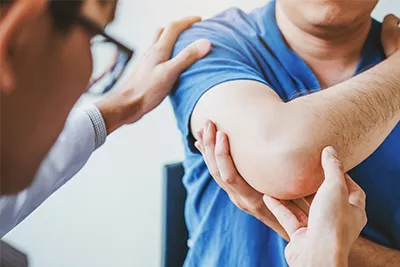Elbow

We treat all types of adult and paediatric acute elbow injuries including humerus, olecranon, radial head fractures, elbow dislocations and tendon ruptures around the elbow (e.g. distal biceps); and chronic conditions such as tennis elbow that has failed conservative treatment measures, elbow stiffness and arthritis
Orthopaedic Conditions Affecting the Elbow

The elbow is known as a ‘sloppy hinge joint’ that is a very stable joint compared to the shoulder. The elbow is formed by the humerus (arm) bone that articulates with the olecranon (which is part of the ulna bone) and the radial head. Acute injuries such as falls on outstretched hands, as well as chronic wear-and-tear can affect the elbow.
Acute Fractures and Dislocations
Fractures around the elbow are very common. In children, humerus fracture occurs just above the elbow joint (supracondylar fractures) or around the radial head. Sometimes there can be fractures along with a dislocation of the elbow (Monteggia fracture/dislocation). Most fractures can typically be managed conservatively with a plaster cast, however, in severe injuries, surgery is required.
Types of elbow fractures in adults include radial head or neck fractures, olecranon fractures and humerus fractures. Most of these injuries require surgery.
Elbow dislocations are relatively uncommon as the elbow is a very stable joint. However, when a dislocation does happen, immediate closed reduction in an emergency department is important. Most of these injuries can be managed conservatively, however, if there are fractures, bone fragments or significant damage to the elbow ligaments (eg lateral ulnar collateral ligament or medial collateral ligament) then surgery is required. In these instances, it is a devastating injury that can take up to a year to recover from.
It is important to note that the elbow is a very unforgiving joint. Stiffness is one of the commonest issues patients face after elbow injuries. Typically it takes 3-6 months to regain most of your movement, however, some patients may never gain full movement.
Distal Biceps Rupture
Tennis elbow is the commonest cause of elbow pain. It commonly causes sharp pain in the elbow, especially on the lateral (outer) side of the elbow and forearm. The muscles that extend the wrist and the fingers originate from the lateral epicondyle (part of the humerus bone near the elbow). One of these tendons (commonly extensor carpi radialis brevis- ECRB) can get micro-tears and degenerate, leading to tennis elbow.
9 out of 10 patients will recover with time (usually 3-6 months). Recovery refers to the resolution of pain, however, the damage to the tendon doesn’t heal by itself. Tennis elbow treatment starts with anti-inflammatories, bracing, night splinting and physiotherapy. However, 1 out of 10 patients will have ongoing pain despite these conservative measures and will go on to need surgery.
In medicine, we typically like to find a unifying diagnosis to explain a patient’s symptoms. However, in about 5% of patients with tennis elbow, they can have a coexisting other condition called radial tunnel syndrome. This is where one of the nerves (posterior interosseous nerve- PIN) gets entrapped as it travels through the forearm.
Patients with radial tunnel syndrome alongside tennis elbow typically have burning pain in the forearm, and sometimes feel weak and their symptoms can be worsened with use of elbow braces. This is a clinical diagnosis as there are no good tests to pick it up. Patients with both diagnoses will usually require surgery to address both problems.
Medial Epicondylitis (Golfers Elbow)
Golfer’s elbows is less common than tennis elbow. It is caused by inflammation and micro-tears within the origin of the flexor tendons. Patients typically have pain in the medial (inner) side of the elbow and forearm.
There can be other issues that can cause pain in the same area, including damage to the medial collateral ligament of the elbow or ulnar nerve entrapment. Therefore, it is important to have a thorough assessment to ensure the cause of the medial elbow pain.
Golfers elbow can be treated with physiotherapy, splinting and corticosteroid. If symptoms persist then surgery can help.
Elbow Arthritis
Elbow arthritis is commonly due to consequences of previous fracture or injury. Inflammatory arthritis (e.g. rheumatoid arthritis) used to cause severe elbow arthritis, but with excellent medical management of these conditions, severe arthritis is rarely seen now.
As we don’t walk on our arms, the elbow is not a weight bearing joint. Although some patients will have elbow joint pain, most patients with elbow arthritis can live without any significant pain. The commonest issue however is stiffness.
In the past we used to think that range of motion of 100 degrees (30-130 degrees) was sufficient. Demands of modern life mean that stiffness is poorly tolerated however. Not only do we need the flexion-extension (bending/straightening) of the elbow, but also rotation (supination to type on a smartphone and pronation to type on a keyboard). So patients with elbow arthritis will seek treatment due to stiffness, as it starts to affect their daily lives and work.
Night splints and physiotherapy can help, however if these options fail, then surgery is the next step. Arthroscopic (key-hole) elbow surgery is very successful in addressing arthritis in the elbow. In severe cases of elbow arthritis, and especially in the elderly, elbow replacement is also an option.
Cubital Tunnel Syndrome
The ulna nerve travels behind the humerus around the elbow joint (commonly referred to as the funny bone). The nerve travels under a series of tunnels and it can get entrapped within these tunnels. This can cause elbow pain, but also numbness and weakness in the hand. Night splints can be tried in early stages of nerve compression, but in severe cases surgery is needed to release the nerve.
Our Expertise
We treat all types of these adult and paediatric acute elbow injuries. Gayan is fellowship-trained in performing arthroscopic and open procedures around the elbow. With most conditions involving the elbow we will initially try conservative options before heading towards surgery.
